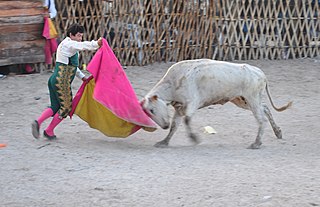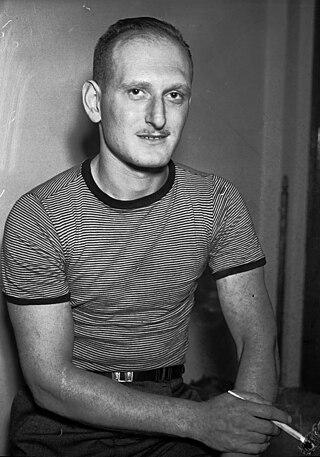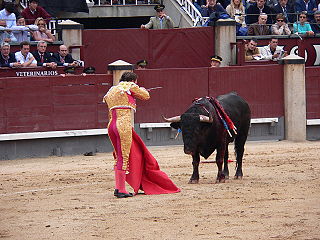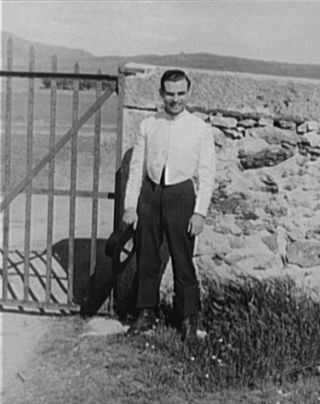Related Research Articles

A bullfighter is a performer in the activity of bullfighting. Torero or toureiro, both from Latin taurarius, are the Spanish and Portuguese words for bullfighter, and describe all the performers in the activity of bullfighting as practised in Spain, Portugal, Mexico, Peru, France, Colombia, Ecuador, Venezuela and other countries influenced by Portuguese and Spanish culture. The main performer and leader of the entourage in a bullfight, and who finally kills the bull, is addressed as maestro (master), or with the formal title matador de toros. The other bullfighters in the entourage are called subalternos and their suits are embroidered in silver as opposed to the matador's gold. They include the picadores, rejoneadores, and banderilleros.

Juan Belmonte García was a Spanish bullfighter. He fought in a record number of bull fights and was responsible for changing the art of bullfighting. He had minor deformities in his legs which forced him to design new techniques and styles of bullfighting.

José Gómez Ortega, commonly known as Joselito, was a Spanish matador in the early twentieth century.
Manolete, also known as The Passion Within in the United Kingdom, Blood and Passion in Canada, and A Matador's Mistress in the United States, is a 2008 biopic of bullfighter Manuel Laureano Rodríguez Sánchez, better known as "Manolete". The film was written and directed by Menno Meyjes. This is the first film from HandMade Films since Lock, Stock and Two Smoking Barrels (1998).

Francisco Rivera Pérez, better known as Paquirri, was a Spanish bullfighter. He died after being gored by a bull named Avispado at the Pozoblanco bullring. During his career, he was six times borne shoulder-high out through the Great Gate at Las Ventas.

The Spanish Fighting Bull is an Iberian heterogeneous cattle population. It is exclusively bred free-range on extensive estates in Spain, Portugal, France and Latin American countries where bullfighting is organized. Fighting bulls are selected primarily for a certain combination of aggression, energy, strength and stamina. In order to preserve their natural traits, during breeding the bulls rarely encounter humans, and if so, never encounter them on foot.

Sidney Franklin was the first American to become a successful matador, the most senior level of bullfighter.

El Fandi is statistically one of the most skilled matadors in the world. Currently, he is ranked number one among all bullfighters in Spain.

Ignacio Sánchez Mejías was a Spanish matador.

Spanish-style bullfighting is a type of bullfighting that is practiced in several Spanish-speaking countries: Spain, Mexico, Ecuador, Venezuela, Peru, as well as in parts of southern France and Portugal. In Colombia it has been outlawed but is being phased out with a full ban coming in effect in 2027. This style of bullfighting involves a physical contest with humans attempting to publicly subdue, immobilize, or kill a bull. The most common bull used is the Spanish Fighting Bull, a type of cattle native to the Iberian Peninsula. This style of bullfighting is seen to be both a sport and performance art. The red colour of the cape is a matter of tradition – bulls are color blind. They attack moving objects; the brightly-colored cape is used to mask blood stains.

Antonio Cayetano Rivera Ordóñez is a Spanish torero or bullfighter.

Bullfighting is a physical contest that involves a bullfighter attempting to subdue, immobilize, or kill a bull, usually according to a set of rules, guidelines, or cultural expectations.

Francis "Frank" Evans is a British-born matador, the most senior form of bullfighter, known as "El Inglés" He is reputed to be the only British bullfighter currently working professionally. He now holds Spanish citizenship.

Domingo Ortega was a Spanish matador. Born Domingo López Ortega in Borox, Toledo, he was the son of a farmer, and grew up helping with farm work. During months when there was no work on the farm, he would travel to other towns selling garlic.
Le petit picador jaune is an oil on wood painting by the Spanish artist Pablo Picasso, which he created in 1889 at the age of eight. It is considered to be the earliest known surviving work by the artist. The painting is a colourful representation of a Spanish bullfight, a subject which Picasso repeatedly returned to throughout his career.

Julio Aparicio Díaz, also known as Julito Aparicio, is a Spanish bullfighter from Seville. Aparicio made his public début in bullfighting at the age of fourteen in 1984. He was confirmed as a torero, or matador, in 1994.
Miguel Báez Espuny, better known as "El Litri", was a Spanish bullfighter, a descendant of one of Huelva's foremost bullfighting dynasties.
Andrés Mazariegos Vázquez, known professionally as Andrés Vázquez "El Nono", was a Spanish bullfighter. Among his influences in tauromachy were Juan Belmonte, Domingo Ortega and Antonio Bienvenida. He was awarded the Order of Beneficence in 1975, and ten times he came out of the Great Gate at Las Ventas. He had great success fighting bulls from the Victorino ranch.

Francisco Camino Sánchez, known in the bullfighting world as Paco Camino, was a Spanish bullfighter and bull breeder. A bullfighter of the highest order, he dominated tauromachy and was twelve times borne shoulder-high out through the Great Gate at Las Ventas in Madrid, a record bested only by Santiago Martín Sánchez.
References
- ↑ Jairo Miguel is his stage name.
- ↑ Texeira, Antonio (2007-07-01). "El niño torero vuelve al ruedo de la muerte (The bullfighting boy returns to the arena of death)". El Mundo (Spain) .
- ↑ Smith-Spark, Laura (2006-05-27). "Growing pains of a child prodigy". BBC.
- 1 2 Woolls, Daniel (2010-02-06). "Teenage Spanish matador kills 6 bulls". AP via Yahoo News.
- ↑ Keeley, Graham (2010-02-06). "Teenage matador Jairo Miguel Sánchez Alonso ready to take on six bulls". The Times of London. Archived from the original on June 4, 2011.